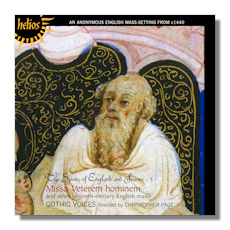
The Internet's Premier Classical Music Source
Related Links
- Dunstable Reviews
- Latest Reviews
- More Reviews
-
By Composer
-
Collections
DVD & Blu-ray
Books
Concert Reviews
Articles/Interviews
Software
Audio
Search Amazon
Recommended Links
Site News
 CD Review
CD Review
The Spirits of England and France

Volume 5 - Missa Veterem
- Anonymous (15th century):
- Mass "Missa Veterem hominem"
- Antiphon "Jesu salvator"
- Carol "Jesu, fili virginis"
- Antiphon "Doleo super te"
- Responsory "Gaude Maria Virgo"
- Plainsong "Deus creator omnium"
- Antiphon "A solis ortus"
- Antiphon "Salvator mundi"
- Antiphon "Christe, qui lux es"
- Carol "To many a well"
- Antiphon "Sancta Maria Virgo"
- Antiphon "Mater ora filium"
- Antiphon "Ave maris stella"
- Antiphon "Pange lingua"
- John Dunstable: Antiphon "Beata mater et innupta virgo", MB 42
Gothic Voices/Christopher Page
Hyperion Helios CDH55285
This is the fifth and final reissue in the splendid series, "The Spirits of England and France", from Gothic Voices under its then director, Christopher Page. It centers around the anonymous fifteenth century mass, Missa Veterem, which is interspersed with other English music of that century and includes John Dunstable's short Beata mater. Indeed, none of the dozen and a half or so pieces is longer than about five and a half minutes.
Volume 4 in this series contained Missa Caput. The Missa Veterem can be regarded as a companion… both are found in the Trent Codices, a collection of seven manuscripts with nearly two thousand pieces from the first 75 years or so of the fifteenth century. This was a time when English music had a huge influence on that of mainland Europe. In fact, in the late 1990s, the English repertoire on this CD represented, a significant expansion of the range of music which Gothic Voices performed. What's more, the fragments of which the music on this CD is a cross section, are themselves but a tiny fraction of what once existed. Missa Veterem is thought to have been written in the late 1440s; it's of the cantus firmus style of mass where each movement is built upon the same borrowed melody. The mass is written for four voices with a low contratenor; and the double cursus format means that the relevant cantus firmus is presented twice in each movement – once each in duple and triple meter. There is, then, a certain fixedness to the structure. Especially given that the melody is repeated. Yet, in common with what is now thought to have been practice, Page interleaves other polyphonic works with the movements of the Mass.
The music, when these structural aspects are assimilated, is as animated as it is innately beautiful. It demands a style of performance that has as much zest and vigor as it has serenity. Gothic Voices understand this and live up to such demands wholeheartedly. They have opted, that is, for a reconstruction that's strictly non-liturgical; rather, an account that's appropriately entertaining, that celebrates the prowess of which singers in the fifteenth century must have been aware – and proud. The works which contrast with the Mass's movements have been carefully chosen, hymns from the "Use of Sarum". The juxtaposition, which nevertheless implicitly requires us to take the first dozen tracks on the CD as a kind of unit, works well.
For instance, the polyphonic texture of the Kyrie of the Mass comes after three monophonic pieces, Doleo super te/Absolon, fili mi, Gaude Maria virgo, and Deus creator omnium. It's not so much a question of our aural palette being refreshed, as of our appreciation of the richness of the polyphonic textures being enhanced: they strike us as all the richer for the contrast. It's also helpful to hear some of the many plainchant melodies on which so much (later) music was based in their unadorned state; we become more aware of their sheer beauty that way.
None of this is to suggest that Gothic Voices' prime purpose is a purely didactic one. While there is likely always to be an informative component in the performance of music so firmly rooted in its own time developmentally, it only communicates when it breathes. As one of the leading ensembles long time expert in this repertoire, Gothic Voices combine the two purposes perfectly: by working outward and upward from technical accuracy, they are able best to squeeze every drop of expression from the music. Or almost. One senses that the singers have, rightly, still much in reserve; that they are sufficiently comfortable with the music's idioms and versed in its idiosyncrasies that it's really music – even after six hundred years – which has as much freshness and is as full of life as if it wad been written last year. These truly are expert performances, and ones to treasure and listen to often.
The booklet carries minimal notes and the texts in Latin/Middle English and Modern English of all the works. The acoustic is close yet not oppressive. If you've been buying these reissues (this was originally released on CDA66919), do not hesitate to add the fifth to your collection.
Copyright © 2011, Mark Sealey.





















